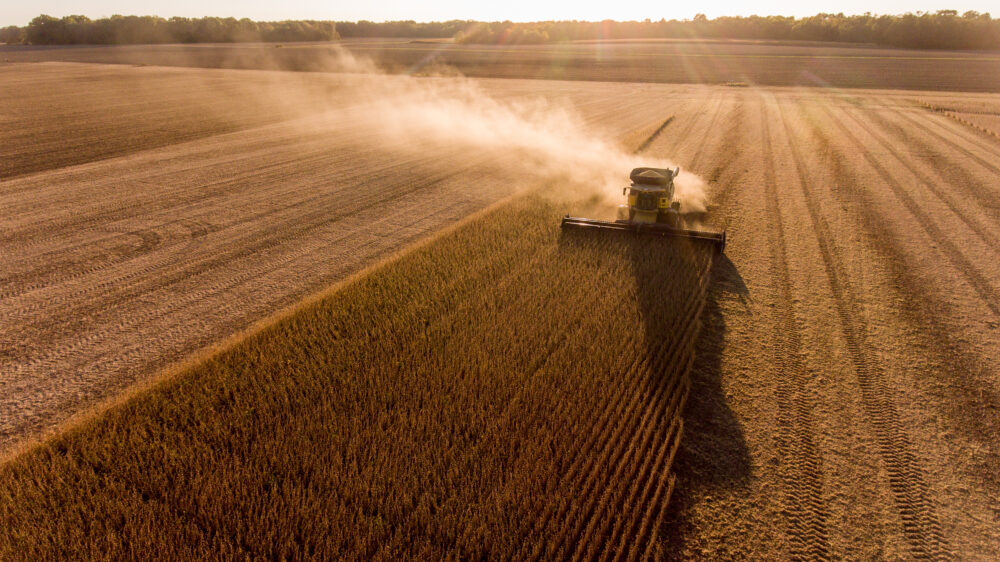Volatile Soybeans Futures Looking For Stability
Share This Story, Choose Your Platform!
Soybeans Current Market
Soybeans play a pivotal role in the global agricultural market, serving as a crucial component in both human food and animal feed industries. Following up on our previous article here, the soybean market continues to face many of the same challenges as we move into the 2024 growing season. This article aims to provide a detailed, fact-based analysis of the current state of the soybean market.
Planting Progress and Initial Conditions
As of May 20, 2024, soybean planting in the United States is underway. According to the USDA’s latest Crop Progress report, approximately 40% of the soybeans have been planted, slightly above the five-year average of 39% but 6% below last year at this point of the year. However, weather conditions have been variable, with some regions experiencing optimal planting conditions while others face delays due to excessive rainfall or drought.
In the Midwest, which accounts for most U.S. soybean production, recent rains have provided much-needed moisture after a dry start to the season. However, areas like the Dakotas and parts of the Southern Plains are still grappling with drought conditions that could impact early crop development.
Supply-Side Factors
The USDA’s latest projections estimate that U.S. soybean acreage for 2024 will reach 86.5 million acres, up 3% from last year, with an expected yield of 52 bushels per acre. This would result in a total production of 4.45 billion bushels, 285 million bushels more than last year’s output. Regionally, Illinois, Iowa, and Minnesota are expected to lead in production, with favorable weather conditions supporting solid yields.
Brazil and Argentina remain key producers globally, with Brazil projected to harvest 154 million metric tons of soybeans for MY 2023/24. Brazil’s estimate for MY 2024/25 is 169 million metric tons, a record if realized on 3.57 tons per hectare. Argentina is projected for 50 million metric tons doubling its production from the 2022/23 marketing year.
The current U.S. soybean stocks-to-use ratio is 10.5%, indicating relatively tight supply conditions. Historically, a ratio below 15% tends to support higher prices, but if it holds up, it would be the first time in five years that it has been over 10%.
Demand-Side Factors
Domestic demand for soybeans remains hefty, driven by strong feed demand from the livestock industry and steady growth in biodiesel production. The Renewable Fuel Standard (RFS) mandates have increased the use of soybean oil for biodiesel, contributing to a higher domestic consumption rate.
Internationally, China continues to be the largest importer of U.S. soybeans, accounting for over 60% of total exports. However, ongoing trade tensions and efforts to diversify supply sources have led China to increase imports from Brazil and Argentina. The recent depreciation of the Chinese yuan against the U.S. dollar has also made American soybeans relatively more expensive, potentially dampening demand.
Trade policies continue to shape the soybean market significantly. The U.S.-China Phase One trade deal saw mixed compliance, with China falling short of its purchasing commitments. Additionally, the European Union’s stringent regulations on genetically modified crops limit market access for U.S. soybeans.
Market Dynamics
Soybean prices have experienced significant volatility over the past year. After peaking at $15 per bushel in late 2023, prices have since retreated to around $12 per bushel. Speculative activity has contributed to this volatility, with hedge funds and other large traders adjusting their positions based on market news and weather forecasts. The latest Commitment of Traders (COT) report from the CFTC shows a net short position in soybean futures, indicating that speculators remain cautious about prices.
Currency exchange rates also play a critical role in soybean pricing. The recent strength of the U.S. dollar has made American soybeans more expensive for international buyers, potentially curbing export demand. Conversely, the depreciation of Brazilian real has made Brazilian soybeans more competitive in the global market.
Seasonal Trend
Historically, the November soybeans contract sees its high in the first half of June. This peak coincides with the critical stages of crop development. As the harvest approaches, prices tend to fall with the addition of new supplies. Adverse weather during the summer months of June and July often creates volatility in the soybean futures contracts.
Long-Term Outlook
Technological advancements in soybean farming, such as precision agriculture and adopting genetically modified (GM) varieties, are expected to enhance yields and reduce production costs over the long term. However, these benefits may be offset by increasing environmental and sustainability concerns. Climate change poses a significant risk to soybean production, with more frequent and severe weather events potentially disrupting supply chains.
Geopolitical factors will also influence the long-term outlook for soybeans. The strengthening alliance between China and Russia and Brazil’s increasing alignment with China could continue to reshape global trade patterns. The U.S. must navigate these changes carefully to maintain its position in the global soybean market.
Final Thoughts
The soybean market is at a critical juncture as we move through the 2024 growing season. While current supply and demand factors suggest a stable market, several potential headwinds could exert downward pressure on prices. Market participants should closely monitor weather conditions, trade policy developments, and global economic trends to make informed decisions. Despite the uncertainties, our long-term outlook for soybeans remains limited with technological advancements increasing yields, increased soybean acreage and the return of Argentina after major drought killing harvests.
Share This Story, Choose Your Platform!
Volatile Soybeans Futures Looking For Stability
Share This Story, Choose Your Platform
Soybeans Current Market
Soybeans play a pivotal role in the global agricultural market, serving as a crucial component in both human food and animal feed industries. Following up on our previous article here, the soybean market continues to face many of the same challenges as we move into the 2024 growing season. This article aims to provide a detailed, fact-based analysis of the current state of the soybean market.
Planting Progress and Initial Conditions
As of May 20, 2024, soybean planting in the United States is underway. According to the USDA’s latest Crop Progress report, approximately 40% of the soybeans have been planted, slightly above the five-year average of 39% but 6% below last year at this point of the year. However, weather conditions have been variable, with some regions experiencing optimal planting conditions while others face delays due to excessive rainfall or drought.
In the Midwest, which accounts for most U.S. soybean production, recent rains have provided much-needed moisture after a dry start to the season. However, areas like the Dakotas and parts of the Southern Plains are still grappling with drought conditions that could impact early crop development.
Supply-Side Factors
The USDA’s latest projections estimate that U.S. soybean acreage for 2024 will reach 86.5 million acres, up 3% from last year, with an expected yield of 52 bushels per acre. This would result in a total production of 4.45 billion bushels, 285 million bushels more than last year’s output. Regionally, Illinois, Iowa, and Minnesota are expected to lead in production, with favorable weather conditions supporting solid yields.
Brazil and Argentina remain key producers globally, with Brazil projected to harvest 154 million metric tons of soybeans for MY 2023/24. Brazil’s estimate for MY 2024/25 is 169 million metric tons, a record if realized on 3.57 tons per hectare. Argentina is projected for 50 million metric tons doubling its production from the 2022/23 marketing year.
The current U.S. soybean stocks-to-use ratio is 10.5%, indicating relatively tight supply conditions. Historically, a ratio below 15% tends to support higher prices, but if it holds up, it would be the first time in five years that it has been over 10%.
Demand-Side Factors
Domestic demand for soybeans remains hefty, driven by strong feed demand from the livestock industry and steady growth in biodiesel production. The Renewable Fuel Standard (RFS) mandates have increased the use of soybean oil for biodiesel, contributing to a higher domestic consumption rate.
Internationally, China continues to be the largest importer of U.S. soybeans, accounting for over 60% of total exports. However, ongoing trade tensions and efforts to diversify supply sources have led China to increase imports from Brazil and Argentina. The recent depreciation of the Chinese yuan against the U.S. dollar has also made American soybeans relatively more expensive, potentially dampening demand.
Trade policies continue to shape the soybean market significantly. The U.S.-China Phase One trade deal saw mixed compliance, with China falling short of its purchasing commitments. Additionally, the European Union’s stringent regulations on genetically modified crops limit market access for U.S. soybeans.
Market Dynamics
Soybean prices have experienced significant volatility over the past year. After peaking at $15 per bushel in late 2023, prices have since retreated to around $12 per bushel. Speculative activity has contributed to this volatility, with hedge funds and other large traders adjusting their positions based on market news and weather forecasts. The latest Commitment of Traders (COT) report from the CFTC shows a net short position in soybean futures, indicating that speculators remain cautious about prices.
Currency exchange rates also play a critical role in soybean pricing. The recent strength of the U.S. dollar has made American soybeans more expensive for international buyers, potentially curbing export demand. Conversely, the depreciation of Brazilian real has made Brazilian soybeans more competitive in the global market.
Seasonal Trend
Historically, the November soybeans contract sees its high in the first half of June. This peak coincides with the critical stages of crop development. As the harvest approaches, prices tend to fall with the addition of new supplies. Adverse weather during the summer months of June and July often creates volatility in the soybean futures contracts.
Long-Term Outlook
Technological advancements in soybean farming, such as precision agriculture and adopting genetically modified (GM) varieties, are expected to enhance yields and reduce production costs over the long term. However, these benefits may be offset by increasing environmental and sustainability concerns. Climate change poses a significant risk to soybean production, with more frequent and severe weather events potentially disrupting supply chains.
Geopolitical factors will also influence the long-term outlook for soybeans. The strengthening alliance between China and Russia and Brazil’s increasing alignment with China could continue to reshape global trade patterns. The U.S. must navigate these changes carefully to maintain its position in the global soybean market.
Final Thoughts
The soybean market is at a critical juncture as we move through the 2024 growing season. While current supply and demand factors suggest a stable market, several potential headwinds could exert downward pressure on prices. Market participants should closely monitor weather conditions, trade policy developments, and global economic trends to make informed decisions. Despite the uncertainties, our long-term outlook for soybeans remains limited with technological advancements increasing yields, increased soybean acreage and the return of Argentina after major drought killing harvests.






